Quince jelly is an easy way to use quince, and it preserves this fragrant fruit right on your pantry shelf.

Quince are one of my husband’s favorite fruits, and it was one of the very first things we planted on our Vermont homestead. They taste like sweet pears scented with rose water, and there’s something inherently exotic about this unassuming warty yellow fruit.
Looking at them on the grocery store shelf, they don’t look all that refined. A bit fuzzy on the outside, and irregular in shape…they’re hardly anything to write home about.
That is, until you catch their intoxicating scent…and then you absolutely have to find quince recipes just for an excuse to bring these beauties home with you.
Quince jelly is one of the simplest quince recipes anywhere, and really, if you can boil water, you can make quince jelly.
Once cooked, those same unassuming yellow fruits turn into rosy pink quince jelly, and their delicious perfumed smell is captured in the jar, just waiting to be spread on your morning toast.
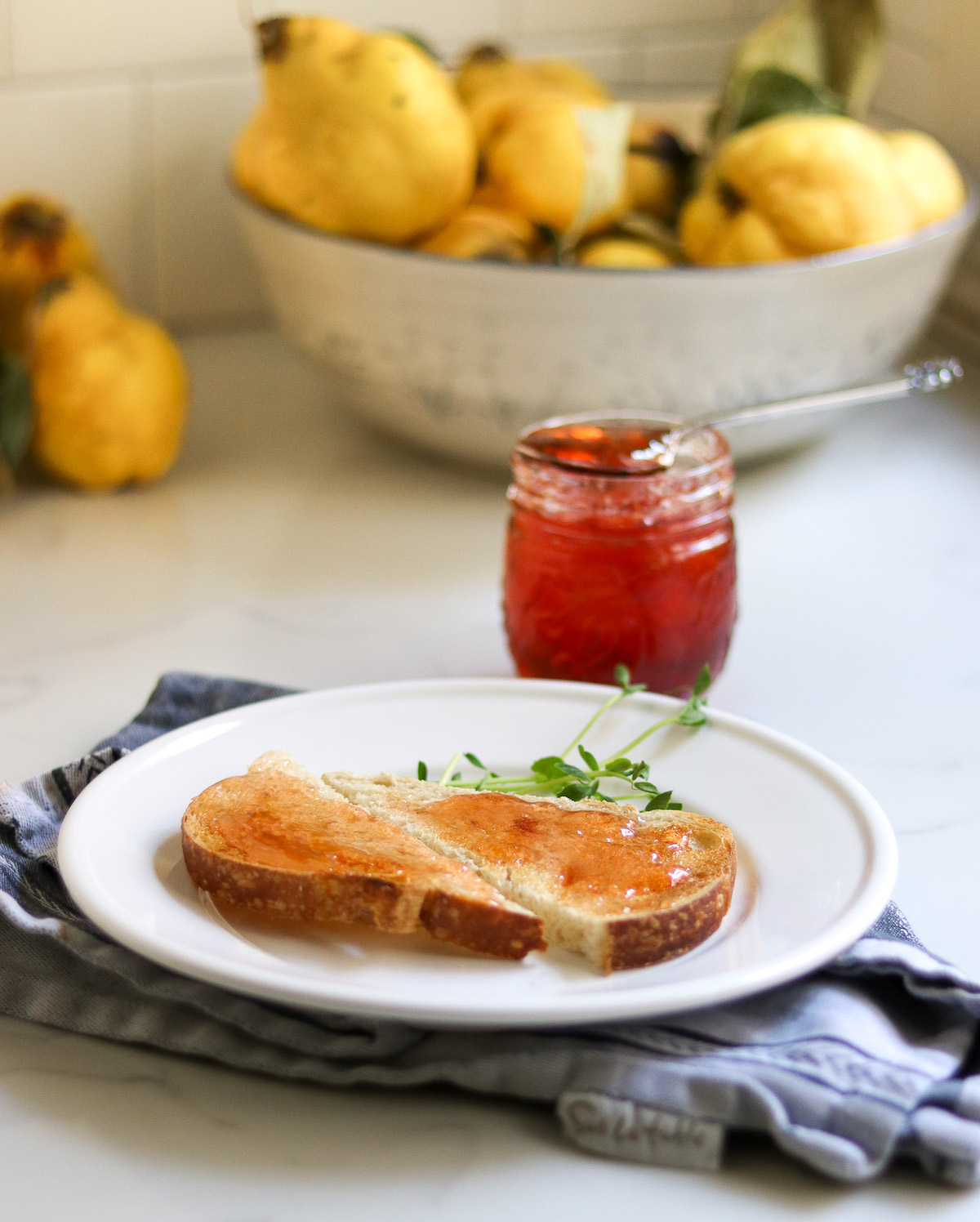
What Are Quince?
Quince are an incredibly fragrant pear-like fruit that grows on a tree in the rose family. They were once very popular, especially in the middle ages, but they’ve become a bit obscure because they can’t be eaten fresh.
To enjoy quince, they must be cooked until they’re completely soft and falling apart. When fresh, they’re hard as a rock, and though they may smell amazing, you’re liable to chip a tooth.
Once cooked, they become sweet and turn a beautiful rosy color. Since they must be cooked, and they’re both fragrant and sweet, they’re often used in preserves.
That includes quince jam and quince jelly, but also as traditional Spanish quince paste (Membrillo).
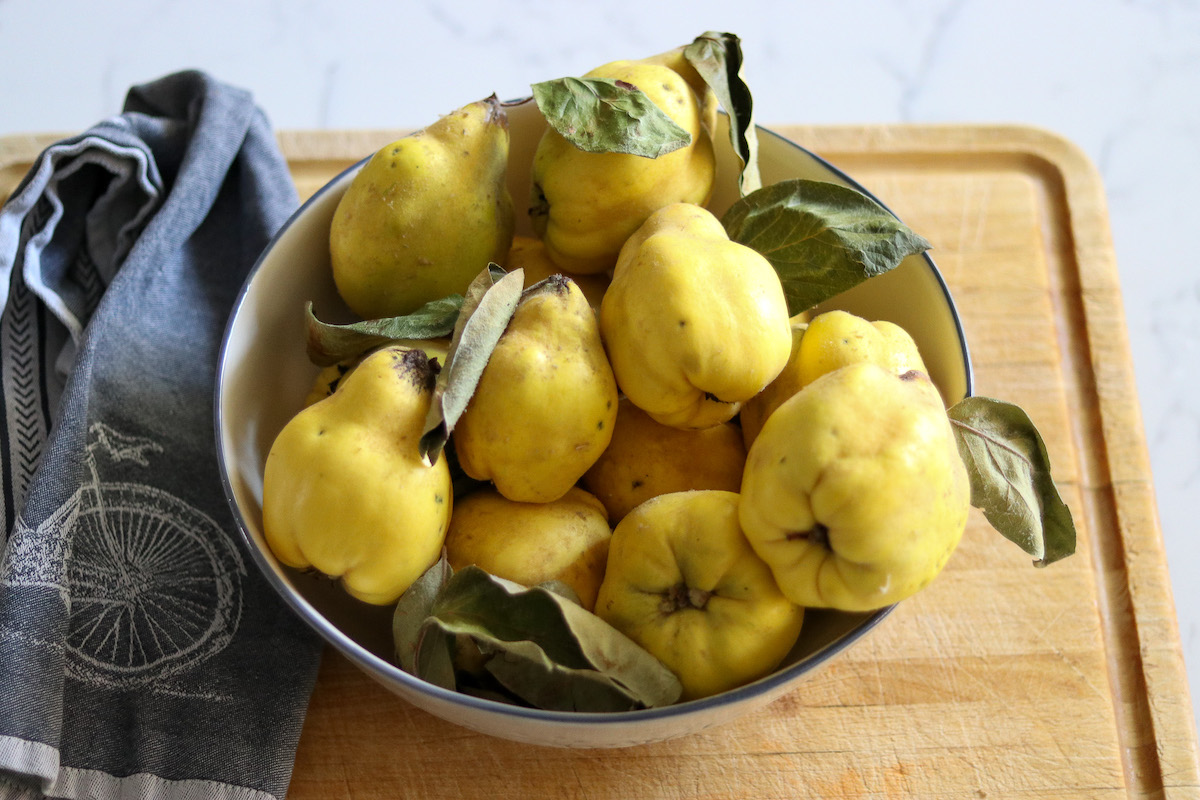
Ingredients for Quince Jelly
The ingredients for quince jelly are quite simple, and all you really need are quince and sugar.
The fruits are high in pectin, so the jelly will set nicely without added boxed pectin. They’re also naturally acidic, like apples and pears, so you don’t need to add lemon juice when preserving.
Lemon juice brings out their flavor though, and goes well with quince jelly. Since it’s not required for preservation, just for flavor, I’d encourage you to use fresh lemon juice.
This recipe for a simple quince jelly is adapted from Food in Jars. To make a batch of 4 half-pint (8 oz) jars, you’ll need:
- 5 lbs (2.3 kg) Quince
- 3 quarts water
- 4 cups (800 g) granulated sugar
- 1/2 cup fresh lemon juice (juice of 2 to 3 medium lemons)
The recipe is pretty standard, and you’ll find the exact same ingredients in just about any preserving book that includes a recipe for quince jelly.
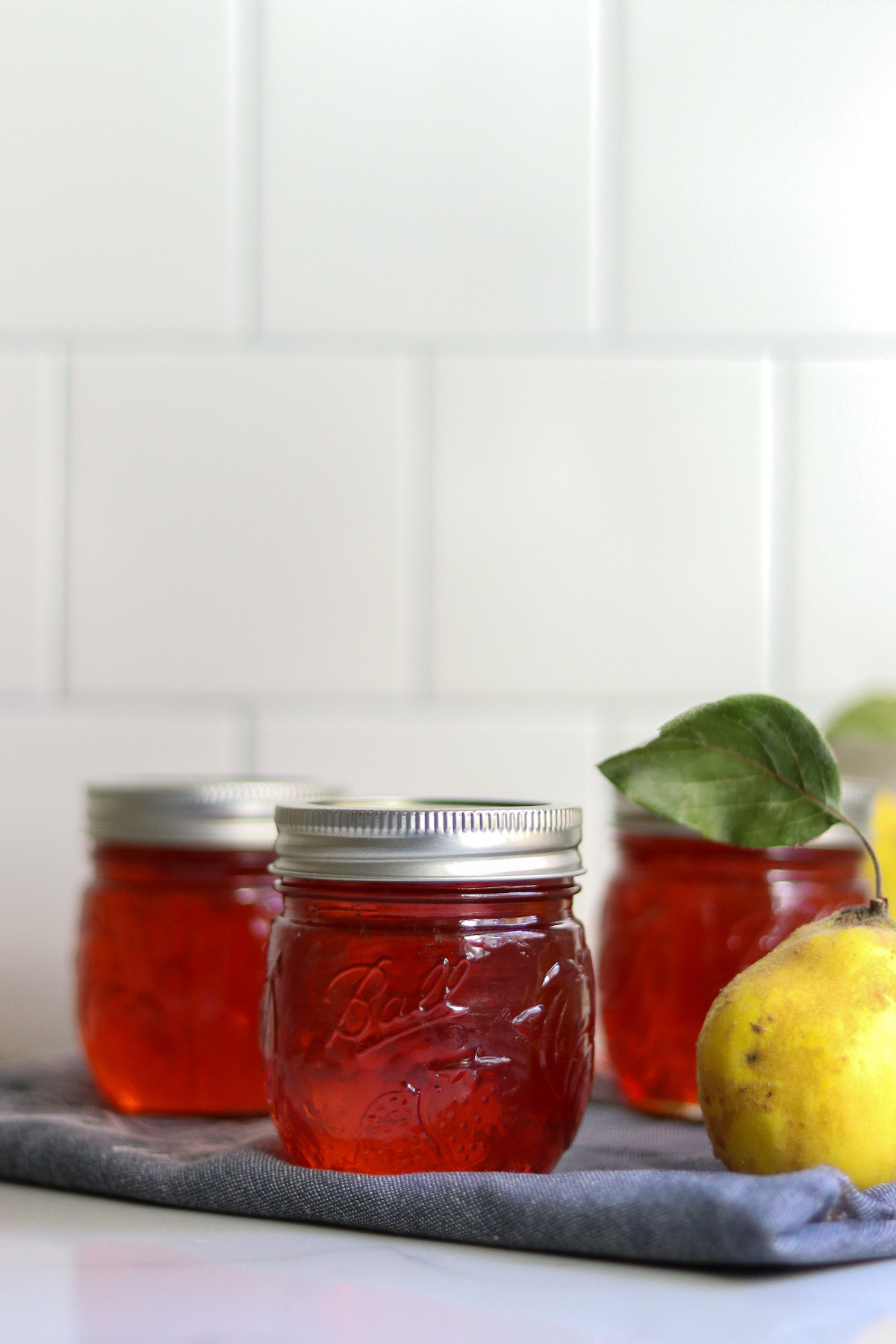
In fact, the preserve goes way back, and the book Savoring the Seasons discussed how the 16th-century scholar Nostradamus, the same one who wrote all manner of apocalyptic prophecy, also wrote a cookbook that includes 7 different ways to preserve quince, and he’s especially fond of quince jelly…
“Nostradamus goes a bit moony over quince jelly, which he describes as ‘supreme in appearance, quality, flavor and excellence, which is suitable for presenting to a king, and which keeps for a long time.”
Pam the Jam: The Book of Preserves has a recipe that’s almost exactly the same, but adds in a small amount of honey for flavor, calling it quince and honey jelly. She still uses sugar to set the jam, though.
You can substitute honey in place of sugar in this recipe, but it won’t set as nicely. Choose light-flavored honey, as it can distract from the aroma of the quince. I love preserving with honey, but in this case, I’d honestly recommend going with sugar for a better-finished flavor (and color).
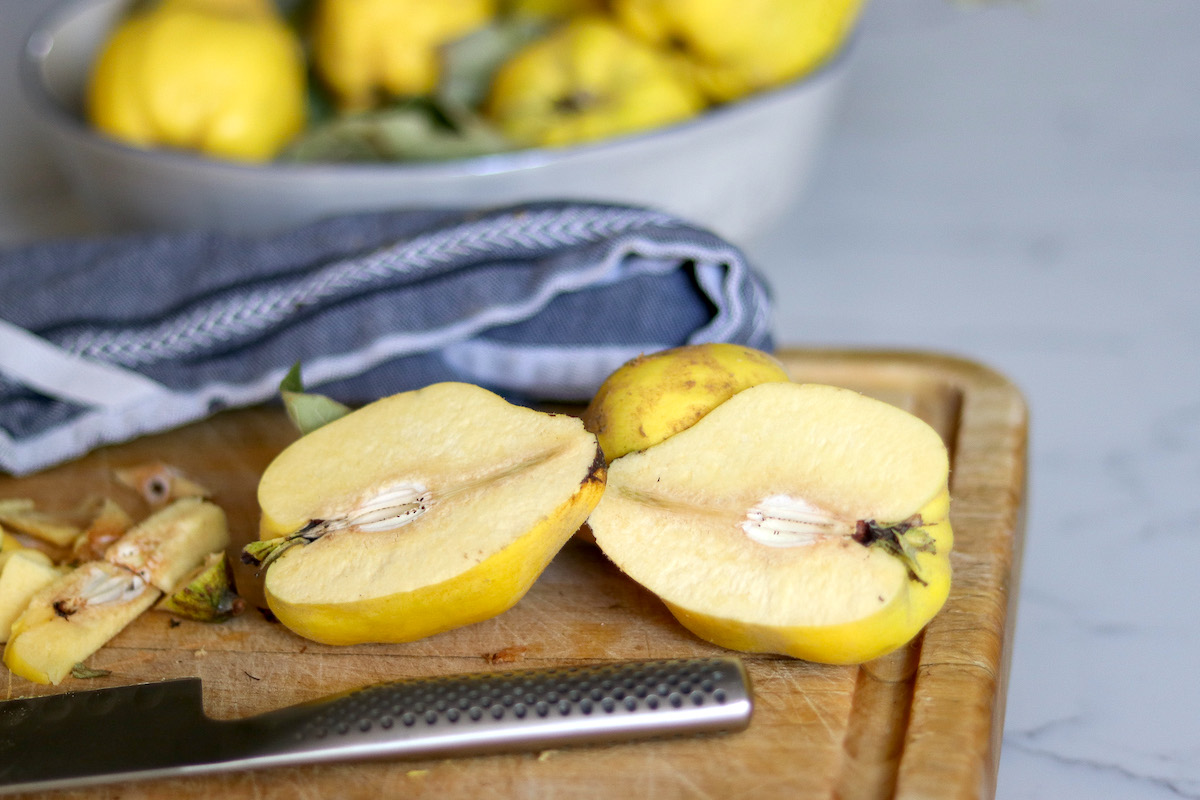
How to Make Quince Jelly
To make quince jelly, start by preparing the quince.
All you really need to do is coarsely chop the quince, and peeling/seeding is optional. That said, I’d suggest that you core the quince so that you can use the leftover pulp for other things.
The pulp is delicious on its own as quince sauce, but it also makes a spectacular quince jam, and it’s what you need to make quince paste (membrillo). If you do it right, you can get two recipes from the same batch of quince.
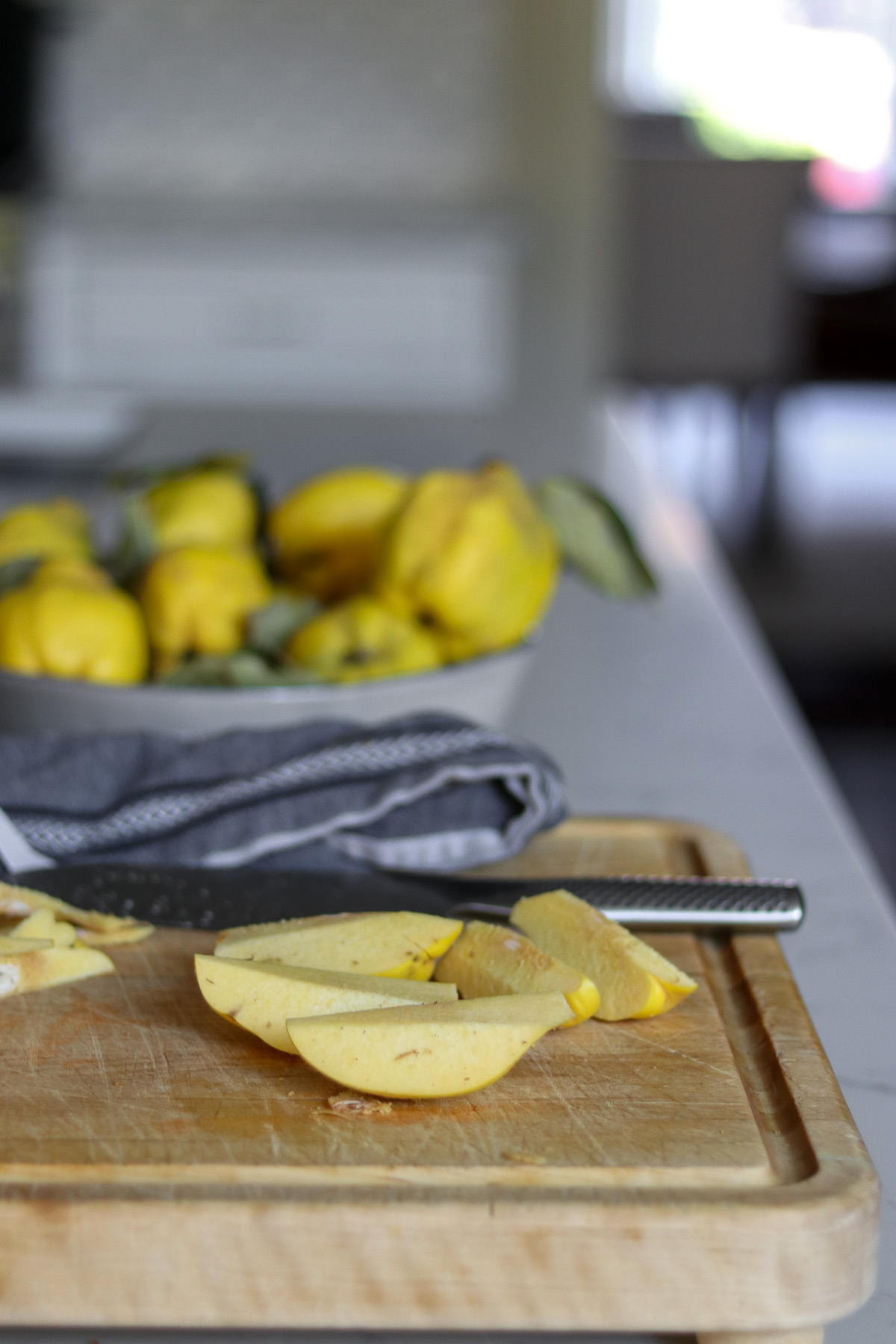
Coring quince for quince jelly
Peeling is optional, and I’d recommend that you don’t peel the quince. The peels mostly disintegrate during cooking, and they’re usually left in when making membrillo.
Nostradamus also has a bit of advice here too…
“Those who peel [the quince]…do not know why they do it; indeed, the peel increases the aroma.”
A lot of the delicious quince flavor is in the peel, so leave that on if you can. It adds pectin to the quince jelly, but more importantly, it also adds amazing flavor and aroma.
(If you must peel for whatever reason, perhaps because you have some other use for the cooked quince pulp that needs to be without peels, the jelly will still work too. In that case, I’d still suggest leaving the peels in, and just running the whole thing through a food mill afterward to get a nice smooth quince sauce without peels.)
Place the quince in a pot with 3 quarts of water and bring it to a boil. Turn the heat down and gently simmer the quince for 2 to 3 hours.
During that time, the water level should have decreased by about half, and the quince should turn a rosy pink color. (Don’t let the water level decrease by more than about half, and if it’s evaporating too fast, add a bit more water in.)
Strain the quince liquid from the fruit using a jelly bag or fine mesh strainer lined with a double layer of dampened cheesecloth. Allow it to strain for several hours, and don’t squeeze the bag. Squeezing will make your quince jelly cloudy.
You should have about 5 cups of strained quince liquid (if you have a bit more or less, that’s fine too).
The liquid can be saved in the refrigerator for up to 3 days, or you can proceed directly to making quince jelly.
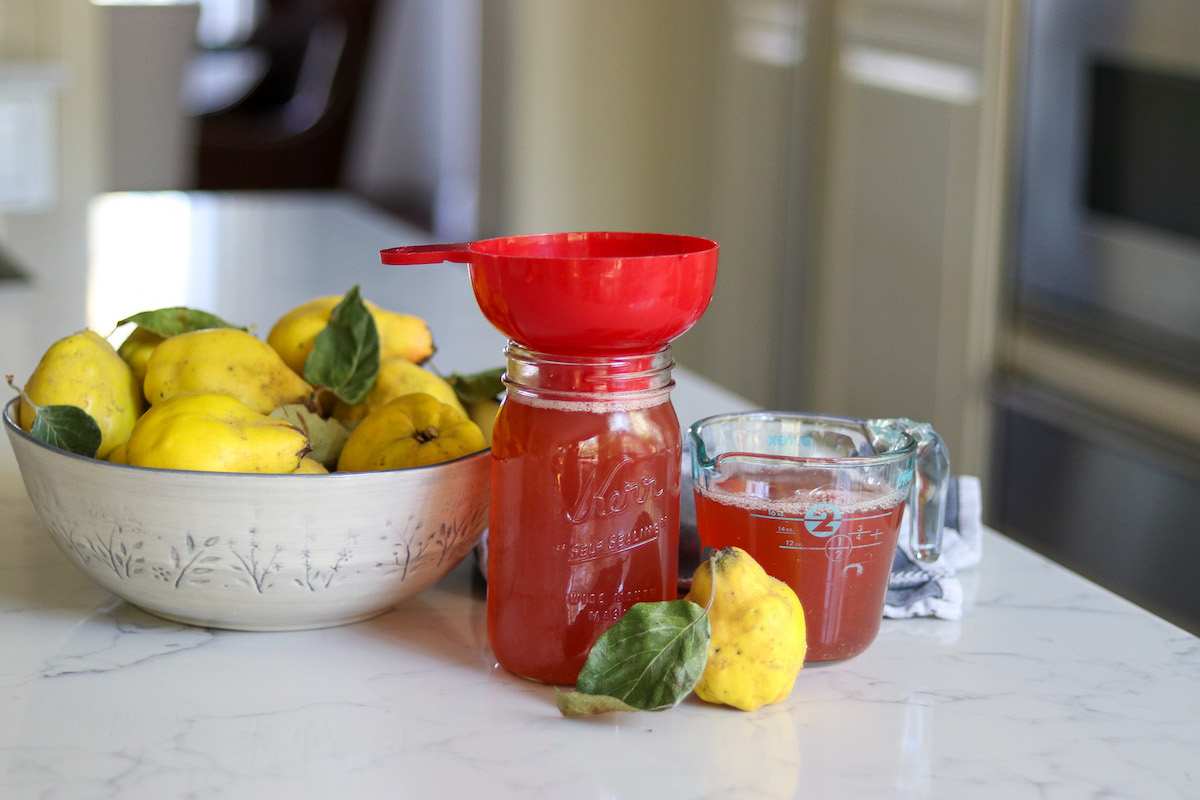
Extracting quince juice for making quince jelly
To make quince jelly from your strained quince juice, start by measuring the juice.
You should have about 5 cups, but measure.
For every cup of quince juice, add 1 cup of sugar. Assuming you have 5 cups juice, you’ll need 5 cups sugar.
Add in about 1/2 cup fresh lemon juice, which is the juice of 2 to 3 medium lemons. Bottled will work too, or you can skip it. It’s not necessary for preservation, but it does really improve the flavor by adding tart notes to balance the sugar.
Bring the quince and sugar mixture to a hard boil in the stove.

Cook the mixture over high heat for about 15 to 25 minutes until it reaches gel stage.
I’d suggest using a candy thermometer here, as it’s hard to judge the exact “set” point just by looking at it…unless you’re a very experienced jelly maker.
Quince jelly is done when it reaches 220 F (105 C) at sea level. That temperature drops by 1 degree for every 500 feet as you go up in elevation, and at 1,000 feet in elevation it should finish at 218 F.
Using a candy thermometer or instant-read thermometer is by far the best way to get a nice set, without burning your jelly.

Lacking a candy thermometer, you can also test the quince jelly set on a plate chilled in the freezer.
Spoon a bit of the jelly mixture out onto the plate, and it’ll flash cool, showing you the finished texture.
Jelly is “set” when you can wrinkle it back with your finger, or trace your finger cleanly thorugh a spoonful on a plate.
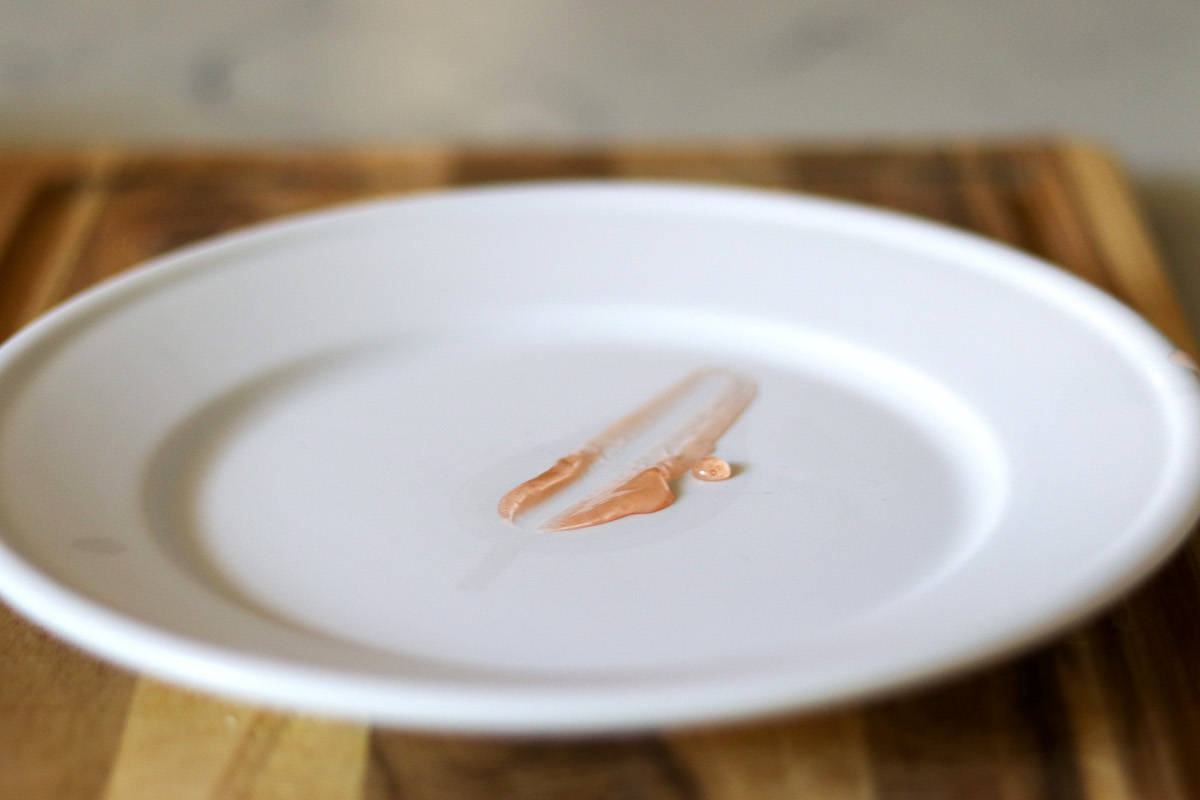
Testing Quince Jelly Set
Once your quince jelly reaches it’s set point, remove the pot from the heat and ladle it into prepared jars.
If you’re canning, be sure to leave 1/4 inch headspace before capping with 2 part canning lids.
Canning is optional, and you can just allow the jelly to cool on the counter and store it in the refrigerator. In Nostradamus’ day, they would have just sealed it with waxed paper and kept it in the cool cellar, where it would keep for several months due to its high sugar content and acidity.
If you want to keep it on you pantry shelf though, I’d suggest canning.
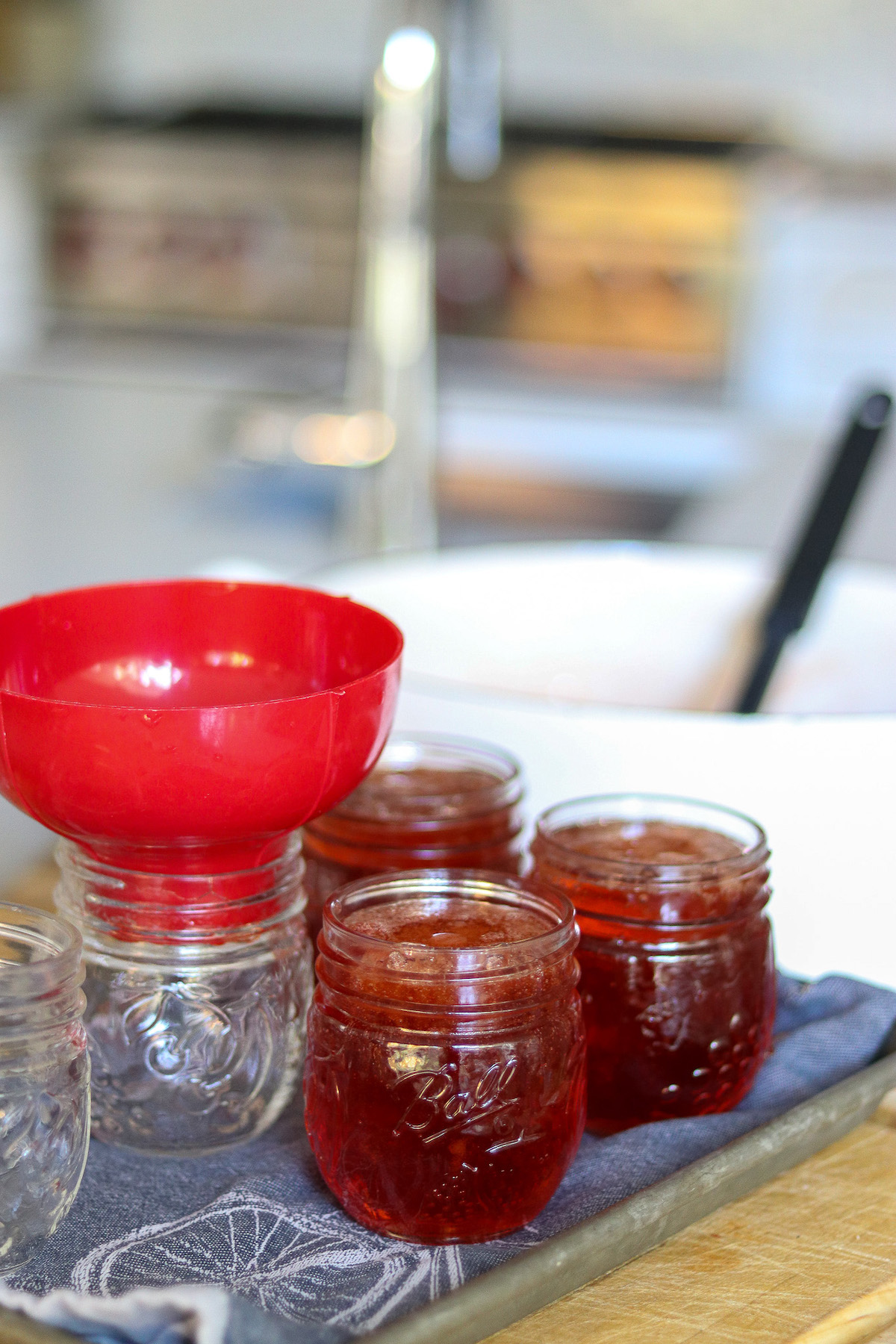
Canning Quince Jelly
If canning, prepare a water bath canner, jars, and rings before you begin cooking the quince jelly. (But after you’ve extracted the quince juice.)
Ladle the quince jelly into canning jars, leaving 1/4 inch headspace. Debubble jars, adjust headspace, and then seal with 2-part canning lids.
Process quince jelly in a water bath canner for 10 minutes (15 minutes above 6,000 feet in elevation).
Once the processing time is complete, use a jar lifter to remove the jars to cool them completely on a towel on the counter. Check seals after 12 to 24 hours, and store any unsealed jars in the refrigerator for immediate use.
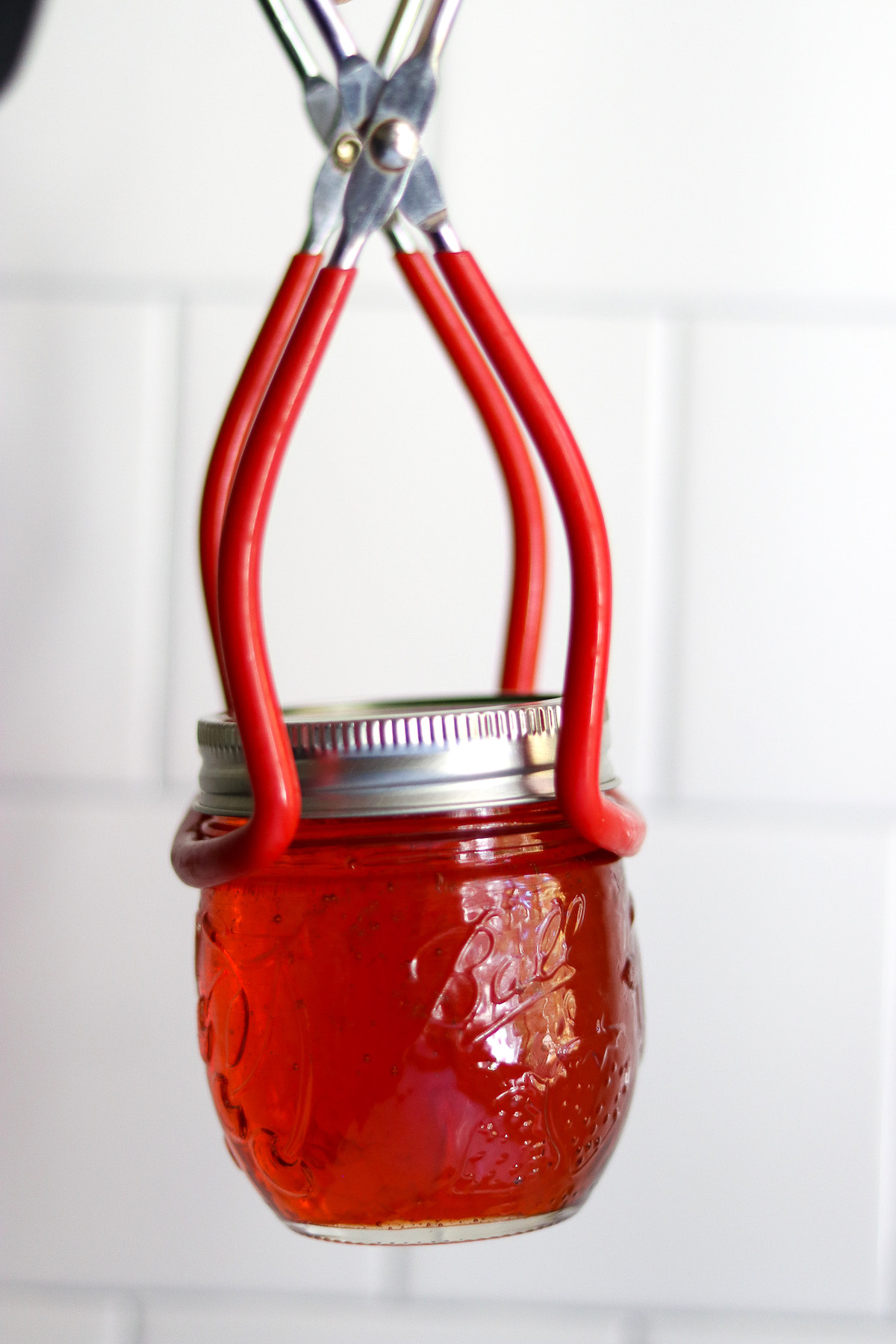
Properly canned and sealed jars of quince jelly should maintain peak quality on the pantry shelf for 18 months, and be good to eat long after.
Refrigerate after opening.
Quince Recipes
Looking for more tasty quince recipes?
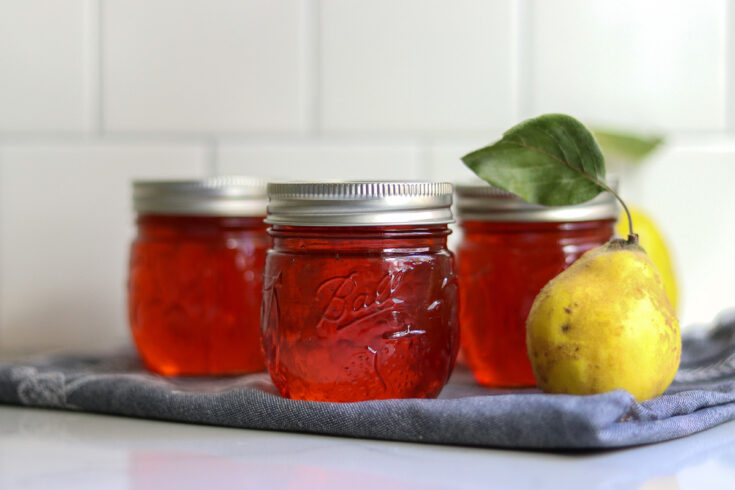
Quince Jelly
Quince jelly is one of the simplest quince recipes anywhere, and it's the perfect way to preserve this fragrant seasonal fruit.
Ingredients
- 5 lbs (2.3 kg) Quince
- 3 quarts water
- 4 cups (800 g) granulated sugar
- 1/2 cup fresh lemon juice (juice of 2 to 3 medium lemons)
Instructions
Extracting Quince Juice for Jelly
- Start by coring and chopping the quince, and then place it in a stock pot with 3 quarts of water.
- Bring the mixture to a boil, and then turn it down to a low simmer. Cook for 2 to 3 hours, until the liquid has reduced by about half and the quince are a rose-y pink color. (Don't let the liquid reduce by more than half, and if it's cooking too fast, add more water.)
- Turn off the stove and strain the mixture thourhg a jelly bag or a fine mesh strainer lined with a double layer of dampened cheesecloth. Allow the mixture to drain for 2 to 3 hours, until you have about 5 cups of liquid collected. (Do not squeeze to extract more juice, just let it drain naturally. Squeezing will result in a cloudy jelly.)
Making Quince Jelly
- If canning, prepare a water bath canner, jars, lids and rings at this point.
- Measure the extracted juice, you should have about 5 cups. (If you have slightly more or less, no worries.)
- Place the measured quince juice into a clean jam pot. Add 1 cup of sugar for each cup of quince juice, adjusting the amount to the amount of juice you extracted.
- Add in about 1/2 cup of lemon juice, or the juice of 2 to 3 lemons. Stir to incorporate.
- Turn on the stove to high heat and bring the mixture to a boil.
- Cook over high heat until the jelly sets, about 15 to 25 minutes. Quince jelly sets at 220 degrees F (105 C) at sea level. That drops by 1 degree for every 500 feet in elevation above sea level, and a 1,000 feet it'll set at about 218 F. Alternately, test for set on a plate that's been chilled in the freezer.
- Once the quince jelly is done, remove it from the heat and ladle into prepared jars, leaving 1/4 inch headspace.
- If canning, process jars in a water bath canner for 10 minutes (or 15 minutes if above 6,000 feet in elevation).
- Once the processing time is complete, use a jar lifter to remove the jars to cool them completely on a towel on the counter. Check seals after 12 to 24 hours, and store any unsealed jars in the refrigerator for immediate use.
Notes
Lemon Juice
The lemon juice in this recipe is for flavor, not preservation. It's highly
recommended but optional. It's not needed for canning safety or
preservation, as quince are naturally are acidic enough for canning. Use either fresh lemon juice (for better flavor) or bottled, if that's what you have. If you want more lemon flavor, add in the zest of 1 lemon as well.
Low Sugar Variation
Quince jelly is naturally quite sweet, and though you can use less sugar, that will just result in a lower yield (rather than a less sweet preserve). The quince jelly will set once the sugar concentration is high enough, and if you use half as much sugar...it'll just cook down more. That may result in a more intense flavor, but it'll be just as sweet, with a lower yield. If you really want a low-sugar version, you can use a low-sugar pectin, like sure jel low sugar. That will allow it to set regardless of the amount of sugar used.
Batch Size
You can safely double the batch size of this recipe to make 8 half pints, but don't increase it beyond that. Very large batch sizes don't cook evenly and have trouble gelling.
Shelf Life
It's perfectly fine to make this quince jelly recipe as a refrigerator jam (or a freezer jam). It'll last several weeks in the refrigerator and up to 6 months in the freezer.
If freezing, be sure to leave plenty of headspace and use freezer-safe jars.
Properly canned and sealed jars of quince jelly will maintain peak quality on the pantry shelf for around 18 months. Past that, they're still good, provided they're sealed, but the quality will start to decline.
Refrigerate after opening.
Autumn Canning Recipes
Putting up more than quince this season?
Easy Jelly Recipes
Keep that jelly pot bubbling with these jelly recipes!

Leave a Reply